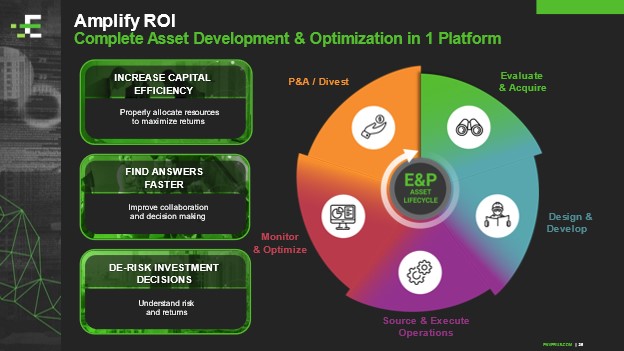So, let’s recap. Back in August, we discussed Phase 1 of the asset lifecycle, “Evaluate & Acquire,” where you benchmark future inventory and forecast existing well performance using insights.
Next up was Phase 2, “Design & Develop,” which allows you to run simulations and understand the asset’s impact from different variables on productivity, using historical and proprietary data.
Now armed with data and forecasts to justify asset development, we’re ready for Phase 3, where we source materials and services and kick off your project. A phase that supports the execution of a company’s operations.

While streamlined processes are critical during drilling, they’re equally as important during sourcing and execution. Streamlining processes help keep projects on time and budget and optimize capital spend by strategically sourcing materials and services.
We’ve all seen capital costs rise due to supply chain bottlenecks, labour shortages and inflation, complicating supplier services. Sourcing services are a non-negotiable part of asset lifecycle management, especially considering that 80% of an operator’s spend is for service costs.
A source-to-pay software does more than automate your sourcing process. It captures valuable spend data that provides insights by looking at many factors, identifying patterns and flagging risk areas. These insights are then used to make informed sourcing decisions.
When you see the big picture, you can increase capital efficiency without having to rely on your gut and hope that the dots will somehow connect in the future. But how do you streamline your sourcing process, provide visibility and manage costs in oil and gas? How does source-to-pay achieve this?
The answer is easy: by automating your source-to-pay process and the associated workflows used to source, order, fulfill services and pay suppliers.
The tough part comes when you make a business case about how digitalizing the source-to-pay process will help your company optimize the asset’s lifecycle and make better sourcing decisions.
Here are some pointers to help you navigate these conversations.
End-to-end digitalization of the sourcing process
Sourcing in oil and gas is often managed through different systems. We place orders by phone or email for work that is usually unplanned, delayed or reactive. We manually enter data from paper field tickets, invoices and contracts, relying on manual oversight to execute them. This demands significant resources to review and process contracts, orders, field tickets and invoices.
In turn, these inefficient, inconsistent processes lead to compliance leakage and rogue spend. They also make benchmarking suppliers and identifying cost savings slow and painful.
Source-to-pay solutions automate the documentation and approval sourcing processes, helping you systematically and consistently identify patterns in your spend. As a result, you save time, streamline your processes and free your staff for higher value-add tasks.
Plus, managing the source-to-pay process in a single platform speeds up collaboration between supply chain, operations, accounting, finance teams and suppliers. This improves process efficiency, allowing you to do more, faster. You get a real-time view on committed spend and gain early insight into cost overrun without adding personnel.
A single source of truth for real-time spend visibility
Unfortunately, silos are often a reality in the energy industry, which involves complex workflows and a flurry of systems. Meaning that to analyze data from different systems, you have to manually export and transfer data from one system to the next. And forget about being able to see all your data in one place in the same language, including data that’s critical to building reports.
Of course, for data to be useful, it must be accurate and reliable. And we all know data integrity is a significant challenge in oil and gas. How can you make decisions without reliable supporting data? Even if you have the data, do you want to look at multiple spreadsheets, with countless sheets and formulas? Probably not.
Managing your source-to-pay process in one platform creates a single source of truth. Enverus Source-to-Pay offers one platform using one language, connected to the largest network of buyers and suppliers in oil and gas. So that in the end, you have a unified way to capture and view spend data.
Custom reporting and dashboards
When it comes to seeing the big picture, reports are crucial. They help provide deeper insights and a bird’s-eye view into cost overrun. Yet, getting the right information into reports is tedious, time-consuming and frustrating.
One way to save time and get insights faster is through custom reporting and dashboards. Enverus’ Source-To-Pay platform caters to specific procurement reporting needs, so you can focus on using data, not managing it. This allows you to quickly diagnose problems, benchmark performance and develop targeted action plans. Our platform builds custom reports, dashboards and visualizations, so you can easily interpret spend data and make informed procurement decisions.
And since not everyone defines success the same way, Enverus’ Source-To-Pay platform also allows for custom views. With it, you can identify differences between projected spend, actual spend and budgets, and spot areas with large variances early on. So that no matter your department, function or seniority, you have the right, actionable information to guide you and your team.
You will be able to point out the differences between projected spend and actual budgets, in turn, creating the kind of long-term vision your high-performing team needs for better accountability.
Automatic price compliance
supportive services at decentralized operations involving numerous back-office systems. This can be complicated to manage — from getting updated pricing information to verifying field tickets and invoices against agreements, items and prices.
The cost of price non-compliance can include rogue spend, price leakage and an overall lack of spend visibility, which eventually leads to a loss of revenue.
With a digital price book, you have all your agreed prices in one place ready to automatically populate orders, tickets and invoices. This ensures all teams use the latest agreed-upon pricing and suppliers aren’t overcharging, helping with cost management.
Enverus’ PriceBook solution takes it one step further by digitalizing the entire process of establishing price lists, validating pricing on field tickets with OpenTicket and verifying pricing on invoices in OpenInvoice.
It makes it easy for service providers to submit pricing changes to new and existing price books directly into OpenInvoice, where changes can be viewed, disputed and approved in an automated workflow. You also gain near real-time visibility crucial for price compliance and handles the manual checking process for better accuracy and efficiency.
Since we are cloud-based, any price compliance update can be rolled out to all employees immediately, no matter how remote their location. This makes it much easier for you to ensure your team remains price compliant.
Cloud-based solutions you can access from anywhere
Salesforce, Amazon, Google, Microsoft, IBM — all of these companies have one thing in common: they all heavily invest in cloud computing.
In contrast, companies in the energy industry are lagging, despite the industry being projected to spend up to $12.4 billion per year by 2030 on cloud computing and analytics, with larger operators like BP and Shell leading the way. But cloud computing isn’t only made for large operators. Regardless of your market cap, you can also benefit from investing in cloud computing.
Cloud-based software accelerates innovation by eliminating the need for a large capital outlay and long delivery timelines for in-house maintenance and feature updates.
Given how increasingly difficult it is to keep all your data, programs and systems up and running internally, you’ll be pleased to hear that the Enverus Source-to-Pay solution suite is accessible via a single cloud-based platform, reducing total cost of application ownership.
Connecting the dots
Enverus’ Source-to-Pay provides a single platform, made for the energy industry, for supply chain, operations and accounting and finance to streamline the process, save time with process automation and view valuable spend data.
You spend less time managing data and more time using it to manage asset lifecycle and make better, reliable sourcing decisions.

Source-to-Pay is especially useful given the tumultuous year oil and gas experienced in 2022.
During SPARK 2022, our annual energy conference, Manuj Nikhanj, president of Enverus, described the year as a series of “once in a lifetime events,” and shared one way to shield yourself from those events.
Want to learn more about how the Enverus Source-to-Pay solution suite can help shield your team from those once-in-a-lifetime events and close your information disconnect? Request a meeting with our sales team today.







